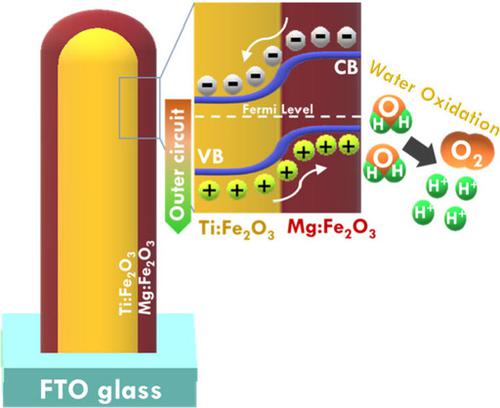当前位置:
X-MOL 学术
›
Chem. Asian J.
›
论文详情
Our official English website, www.x-mol.net, welcomes your
feedback! (Note: you will need to create a separate account there.)
Heteroatom Doping Strategy for Establishing Hematite Homojunction as Efficient Photocatalyst for Accelerating Water Splitting.
Chemistry - An Asian Journal ( IF 3.5 ) Pub Date : 2020-09-21 , DOI: 10.1002/asia.202001021 Shang-Mao Tao,Ren-Jei Chung,LuYin Lin
Chemistry - An Asian Journal ( IF 3.5 ) Pub Date : 2020-09-21 , DOI: 10.1002/asia.202001021 Shang-Mao Tao,Ren-Jei Chung,LuYin Lin

|
Hematite (α‐Fe2O3) is one of the promising photocatalysts for water oxidation, owing to its stable, abundant and visible‐light responsive features. Enhancing electrical conductivity and accelerating oxidation evolution kinetics are expected to improve photocatalytic ability of hematite toward water oxidation. In this work, strategies of doping heteroatoms and developing pn homojunction are adopted to enhance the photocatalytic ability of hematite electrodes. The Ti and Mg dopants are separately incorporated in two layers of hematite electrodes via two‐step hydrothermal reaction and one‐step annealing process. The effect of regrowth time for synthesizing Mg‐doped hematite on the photoelectrochemical performance of Mg‐doped and Ti‐doped hematite (Mg−Fe2O3/Ti−Fe2O3) electrode is studied. The size of rod‐like structure and gaps in‐between play important roles on the photocatalytic ability of Mg−Fe2O3/Ti−Fe2O3. The optimized Mg−Fe2O3/Ti−Fe2O3 electrode is prepared by using merely 10 min for synthesizing the Mg‐doped hematite top layer, which shows the highest photocurrent density of 2.83 mA/cm2 at 1.60 VRHE along with the highest carrier density of 5.89×1016 cm−3 and the smallest charge‐transfer resistance. This largely improved photoelectrochemical performance is attributed to the more donor generation with heteroatom‐doping and more efficient charge cascade with homojunction establishment. Other p‐type metals are encouraged to dope in hematite as the second layer to couple with the n‐type Ti‐doped hematite for developing efficient pn homojunction and improve the photocatalytic ability of hematite in the near future.
中文翻译:

建立赤铁矿同质结作为促进水分解的高效光催化剂的杂原子掺杂策略。
赤铁矿(α-的Fe 2 ö 3)是有前途的用于光催化剂水氧化之一,由于其稳定,丰富的和可见光响应特征。增强电导率和加速氧化演化动力学有望改善赤铁矿对水氧化的光催化能力。在这项工作中,采用掺杂杂原子和形成pn同质结的策略来增强赤铁矿电极的光催化能力。Ti和Mg掺杂剂通过两步水热反应和一步退火工艺分别掺入两层赤铁矿电极中。再生时间对掺Mg赤铁矿的影响对掺Mg和Ti掺杂的赤铁矿(Mg-Fe 2 O研究了3 / Ti-Fe 2 O 3)电极。棒状结构的尺寸和它们之间的间隙对Mg-Fe 2 O 3 / Ti-Fe 2 O 3的光催化能力起重要作用。优化的镁-铁2 ö 3 /钛-铁2 ö 3电极通过使用仅仅10分钟用于合成Mg掺杂赤铁矿顶层制备,其中的节目2.83毫安/厘米的最高光电流密度2 1.60 V RHE沿最高载流子密度为5.89×10 16 cm -3和最小的电荷转移电阻。这种光电化学性能的大幅提高归因于杂原子掺杂产生了更多的供体,同质结建立了更有效的电荷级联。鼓励将其他p型金属掺杂在赤铁矿中,作为第二层与n型Ti掺杂的赤铁矿耦合,以开发有效的pn同质结并在不久的将来提高赤铁矿的光催化能力。
更新日期:2020-11-17
中文翻译:

建立赤铁矿同质结作为促进水分解的高效光催化剂的杂原子掺杂策略。
赤铁矿(α-的Fe 2 ö 3)是有前途的用于光催化剂水氧化之一,由于其稳定,丰富的和可见光响应特征。增强电导率和加速氧化演化动力学有望改善赤铁矿对水氧化的光催化能力。在这项工作中,采用掺杂杂原子和形成pn同质结的策略来增强赤铁矿电极的光催化能力。Ti和Mg掺杂剂通过两步水热反应和一步退火工艺分别掺入两层赤铁矿电极中。再生时间对掺Mg赤铁矿的影响对掺Mg和Ti掺杂的赤铁矿(Mg-Fe 2 O研究了3 / Ti-Fe 2 O 3)电极。棒状结构的尺寸和它们之间的间隙对Mg-Fe 2 O 3 / Ti-Fe 2 O 3的光催化能力起重要作用。优化的镁-铁2 ö 3 /钛-铁2 ö 3电极通过使用仅仅10分钟用于合成Mg掺杂赤铁矿顶层制备,其中的节目2.83毫安/厘米的最高光电流密度2 1.60 V RHE沿最高载流子密度为5.89×10 16 cm -3和最小的电荷转移电阻。这种光电化学性能的大幅提高归因于杂原子掺杂产生了更多的供体,同质结建立了更有效的电荷级联。鼓励将其他p型金属掺杂在赤铁矿中,作为第二层与n型Ti掺杂的赤铁矿耦合,以开发有效的pn同质结并在不久的将来提高赤铁矿的光催化能力。











































 京公网安备 11010802027423号
京公网安备 11010802027423号